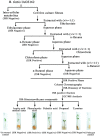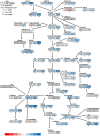Phenylacetic Acid Is ISR Determinant Produced by Bacillus fortis IAGS162, Which Involves Extensive Re-modulation in Metabolomics of Tomato to Protect against Fusarium Wilt
- PMID: 27148321
- PMCID: PMC4835451
- DOI: 10.3389/fpls.2016.00498
Phenylacetic Acid Is ISR Determinant Produced by Bacillus fortis IAGS162, Which Involves Extensive Re-modulation in Metabolomics of Tomato to Protect against Fusarium Wilt
Abstract
Bacillus fortis IAGS162 has been previously shown to induce systemic resistance in tomato plants against Fusarium wilt disease. In the first phase of current study, the ISR determinant was isolated from extracellular metabolites of this bacterium. ISR bioassays combined with solvent extraction, column chromatography and GC/MS analysis proved that phenylacetic acid (PAA) was the potential ISR determinant that significantly ameliorated Fusarium wilt disease of tomato at concentrations of 0.1 and 1 mM. In the second phase, the biochemical basis of the induced systemic resistance (ISR) under influence of PAA was elucidated by performing non-targeted whole metabolomics through GC/MS analysis. Tomato plants were treated with PAA and fungal pathogen in various combinations. Exposure to PAA and subsequent pathogen challenge extensively re-modulated tomato metabolic networks along with defense related pathways. In addition, various phenylpropanoid precursors were significantly up-regulated in treatments receiving PAA. This work suggests that ISR elicitor released from B. fortis IAGS162 contributes to resistance against fungal pathogens through dynamic reprogramming of plant pathways that are functionally correlated with defense responses.
Keywords: Bacillus; fusarium wilt; induced systemic resistance (ISR); phenylacetic acid; tomato.
Figures







Similar articles
-
Identification of a Potential ISR Determinant from Pseudomonas aeruginosa PM12 against Fusarium Wilt in Tomato.Front Plant Sci. 2017 May 31;8:848. doi: 10.3389/fpls.2017.00848. eCollection 2017. Front Plant Sci. 2017. PMID: 28620396 Free PMC article.
-
The Imperative Use of Bacillus Consortium and Quercetin Contributes to Suppress Fusarium Wilt Disease by Direct Antagonism and Induced Resistance.Microorganisms. 2023 Oct 21;11(10):2603. doi: 10.3390/microorganisms11102603. Microorganisms. 2023. PMID: 37894261 Free PMC article.
-
Bacillus subtilis NBRI-W9 simultaneously activates SAR and ISR against Fusarium chlamydosporum NBRI-FOL7 to increase wilt resistance in tomato.J Appl Microbiol. 2024 Mar 1;135(3):lxae013. doi: 10.1093/jambio/lxae013. J Appl Microbiol. 2024. PMID: 38268411
-
Interactions of Bacillus spp. and plants--with special reference to induced systemic resistance (ISR).Microbiol Res. 2009;164(5):493-513. doi: 10.1016/j.micres.2008.08.007. Epub 2008 Oct 8. Microbiol Res. 2009. PMID: 18845426 Review.
-
Arabidopsis defense response against Fusarium oxysporum.Trends Plant Sci. 2008 Mar;13(3):145-50. doi: 10.1016/j.tplants.2007.12.004. Epub 2008 Mar 4. Trends Plant Sci. 2008. PMID: 18289920 Review.
Cited by
-
Integrated Genomic and Metabolomic Analysis Illuminates Key Secreted Metabolites Produced by the Novel Endophyte Bacillus halotolerans Cal.l.30 Involved in Diverse Biological Control Activities.Microorganisms. 2022 Feb 9;10(2):399. doi: 10.3390/microorganisms10020399. Microorganisms. 2022. PMID: 35208854 Free PMC article.
-
Cyclic Lipopeptides of Bacillus amyloliquefaciens DHA6 Are the Determinants to Suppress Watermelon Fusarium Wilt by Direct Antifungal Activity and Host Defense Modulation.J Fungi (Basel). 2023 Jun 19;9(6):687. doi: 10.3390/jof9060687. J Fungi (Basel). 2023. PMID: 37367623 Free PMC article.
-
Phenylacetic Acid and Methylphenyl Acetate From the Biocontrol Bacterium Bacillus mycoides BM02 Suppress Spore Germination in Fusarium oxysporum f. sp. lycopersici.Front Microbiol. 2020 Nov 27;11:569263. doi: 10.3389/fmicb.2020.569263. eCollection 2020. Front Microbiol. 2020. PMID: 33329425 Free PMC article.
-
The antibacterial mechanism of phenylacetic acid isolated from Bacillus megaterium L2 against Agrobacterium tumefaciens.PeerJ. 2022 Nov 8;10:e14304. doi: 10.7717/peerj.14304. eCollection 2022. PeerJ. 2022. PMID: 36389424 Free PMC article.
-
Extracts from cultures of Pseudomonas fluorescens induce defensive patterns of gene expression and enzyme activity while depressing visible injury and reactive oxygen species in Arabidopsis thaliana challenged with pathogenic Pseudomonas syringae.AoB Plants. 2019 Jul 29;11(5):plz049. doi: 10.1093/aobpla/plz049. eCollection 2019 Oct. AoB Plants. 2019. PMID: 31632627 Free PMC article.
References
-
- Abe U., Uchiyama M., Sato R. (1974). Isolation of phenylacetic acid and its p-hydroxy derivative as auxin like substances from Undaria pinnatifida. Agric. Biol. Chem. 38 897–898. 10.1271/bbb1961.38.897 - DOI
-
- Akram W., Anjum T., Ali B. (2015). Searching ISR determinant/s from Bacillus subtilis IAGS174 against Fusarium wilt of tomato. Biocontrology 60 271–280. 10.1007/s10526-014-9636-1 - DOI
-
- Akram W., Anjum T., Ali B., Ahmad A. (2013). Screening of native bacillus strains to induce systemic resistance in tomato plants against fusarium wilt in split root system and its field applications. Int. J. Agric. Biol. 15 1289–1294.
LinkOut - more resources
Full Text Sources
Other Literature Sources
Miscellaneous

